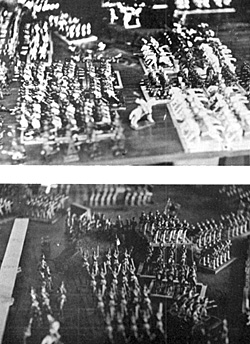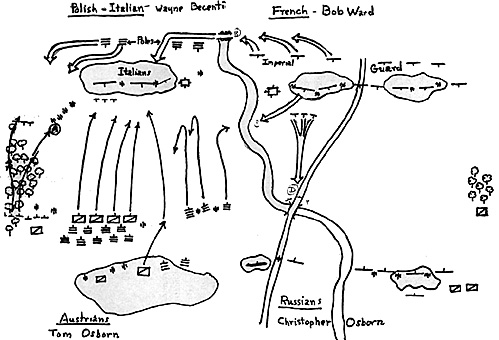 Our wargaming group here in Los Angeles has been together now
for about two years. The group began with only five members and we
now have nearly twenty wargamers and 8000 30mm Napoleonic figures.
Each member of our group has his own country and is allowed to have
any number of figures he wishes as long as his country actually had the
particular unit he has painted. We insist on accurate uniform and
equipment detail, but that is as far as our historical limitations go.
Our wargaming group here in Los Angeles has been together now
for about two years. The group began with only five members and we
now have nearly twenty wargamers and 8000 30mm Napoleonic figures.
Each member of our group has his own country and is allowed to have
any number of figures he wishes as long as his country actually had the
particular unit he has painted. We insist on accurate uniform and
equipment detail, but that is as far as our historical limitations go.
Size of armies and alliances are up to each player to decide. As you can imagine, this leads to some interesting situations. In one recent war, for example, Russia was invaded by a combined force of Swedes, Danes and Americans. Here is a table of the approximate strengths of our various armies:
-
France 1400
England 450
Russia 1000
Italy 300
Austria 700
Poland 300
Denmark 650
Sweden 250
U. S. A. 600
Westphalia 250
Confederation of the Rhine 300
Spain 600
Saxony 150
Hanover 40
Bavaria 425
Portugal 120
Naples 500
Baden 100
Prussia 500
Brunswick 100
Wurtemburg 123
Our rules are based on John Candler's book Miniature Wargames du temps de Napoleon, but we have introduced a number of modifications. We use a system of single figures mounted on balsa wood trays-10 men per tray for infantry, 5 per tray for cavalry. One tray is a batallion of infantry or a squadron of cavalry. Our organization is 2 to 4 batallions (usually 3) making an infantry regiment, and 4 to 6 squadrons(usually 4) making a cavalry regiment. Our troop ratios generally run about one cavalry man for 3 infantry, one engineer for every 50 men, and one gun per 100 men.
Most of our battles are fought on a 6 x 12 ft. table and average about 1000 per side, though battles with 1500 per side are not rare. We usually fight in campaigns and, since it is necessary to form alliances, we combine diplomacy with our wargames. We also have a system of keeping track of losses and of providing reinforcements for our units. Each unit's losses are divided by 3. The first third are lightly wounded; they come back for the next battle. The second third are heavily wounded; they return one battle later. The rest are dead. This provides a steady flow of replacements and also assures that no unit can be unrealistically "wiped out".
In addition to these rules, we also add a few "personal" touches. Most players keep a record book with the names of each unit, what battles they were in, casualties, battle honors, etc. We also allow captured standards to be kept. (The Confederation of the Rhine is highest with 22; my Russians have 19.)
To illustrate what our battles are like I have included a brief description of one of our latest encounters.
Battle
The French, determined to defend, had sent their cavalry off the field and divided their infantry evenly. The French on their left, the Italo- Polish on the right. The allies decide to advance on the left bank, leaving only a slight covering force on the right. The Austrians made most of the attacks. First, cavalry charged the ridge held by two Italian regiments with skirmishes on the slopes. These faded to penetrate, but two successive waves of infantry columns did manage, at heavy cost, to lodge themselves on the ridge.
To the left of the main attack, Austrian Jagers (3 regiments) had cleared the French light infantry out of the woods and, moving through, captured a gun which had been damaged and abandoned. (A) When the others withdrew. Two Polish infantry and one lancer regiment formed up beside the ridge in front of the woods, preventing the Austrians from advancing. On the right, a Russian supporting drive was stopped by French reinforcements (the Imperial Guard) crossing pontoon bridge (B) and enfilade fire from across the river (C).
Apart from some minor skirmishing and artillery fire (D) the rest of the field was quiet. It was now getting dark and the Austrians, who had caught sight of the advancing bearskins of the Imperial Guard, withdrew from the ridge unmolested. The battle was a stalemate (about 250 losses each) but the allies morale was low so they withdrew from the field.

Back to The Armchair General Vol. 1 No. 4 Table of Contents
Back to The Armchair General List of Issues
Back to MagWeb Master Magazine List
© Copyright 1999 by Pat Condray
This article appears in MagWeb (Magazine Web) on the Internet World Wide Web. Other military history articles and gaming articles are available at http://www.magweb.com
